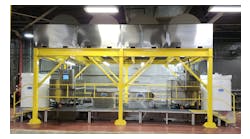Q
New reduced lead requirements for drinking water contact equipment are going into effect soon. What is the lead issue and how do the new requirements affect me?
A
Lead is a metal that was widely used as lead oxides in red and white paint, as metal in canned food container solders, in production of tetraethyl lead gasoline additive, in brass and in drinking water pipe solders and fluxes. Most leaded paint use has been banned in the U.S. since 1978, but road paints may still contain it. Houses built before 1978 can have lead paint indoors or outdoors. Renovations have been a cause of elevated lead levels in resident children probably through dust inhalation and pica (ingesting dust and dirt particles).
At one time lead was widely used as water pipe in the U.S. because of its ease of manufacture and long-term stability. In 1897, more than half of U.S. cities were major users of lead pipe or service lines. By the 1920s many cities began to discourage use of lead pipe, but even as late as 1984 codes in several major cities still permitted use of lead pipe. Lead water pipes and lead service lines still remain in many locations in many cities, although pipe removals are occurring by attrition and renovations and service lines are replaced when water mains are replaced.
Lead health concerns
Lead is a toxic heavy metal. What is not excreted is held temporarily in blood and ultimately deposited in bone, where it can be remobilized during pregnancy or aging or due to calcium deficiency. There were numerous reports of childhood lead poisonings and deaths in the late 19th and early 20th centuries in cities with new lead pipe and corrosive waters.
Child blood lead levels in the U.S. have declined significantly since the elimination of leaded gasoline and lead can container and water pipe solders. Since the 1976-1980 period the mean child blood lead level has fallen from micrograms per deciliter (µg per 100 ml of blood = µg/dl) to ~1 µg/dl. About 2.5 percent of one- to five-year-olds currently exceed 5 µg/dl. The principal environmental exposure risk is neurotoxicity, especially in infants and young children. Consumption of lead paint and soil pica is a high dose route of exposure and still the cause of major lead toxicity concerns. Developmental deficits can include subtle, but reversible IQ losses that are suspected to occur at levels about 5-10 µg/dl.
Water issues and water treatment
Lead is usually not present at high levels in source waters and seldom at more than trace levels in treated drinking water. The principal sources of exposure from drinking water are leaded brass faucets, old lead service lines and old leaded pipe joint solders. Old galvanized water pipe has been shown to accumulate lead, probably on iron oxide particulates, and significant lead water levels are reached when they are mobilized. Lead can be leached into drinking water by dissolution, but lead particulates may also be released. If the action level described below in the regulations section is exceeded, the water supply is required to take corrective actions to reduce the corrosivity of the water. Corrective actions often involve pH or alkalinity adjustments and might involve use of orthophosphates or silicates to reduce the corrosivity of the water. If that is insufficient, replacement of existing lead service lines is required. There is a debate on the long-term consequences of partial lead service line replacement, i.e., when the public segment from the meter to the water main is replaced, but not the private segment from the home to the water main.
There have been examples of increased lead extraction when water suppliers switched from free chlorine residuals to chloramine combined chlorine residuals. Orthophosphates added at a few mg/l have been successful in restoring the passivated surface on leaded materials, including lead service pipes, and reducing the lead releases.
POU treatments are readily available for lead reduction at the tap, as well as pour through containers. Numerous manufactured products are available that can claim lead reduction. They often utilize zeolites as part of the system for removal of dissolved lead. More recent certifications also require demonstrated lead particulate removal.
Regulations and statutes
Part 141.43 of the National Primary Drinking Water Regulations prohibited use/installation of lead pipe, lead solder and flux after June 19, 1986 and defined low lead content at that time. Brass with lead content greater than eight percent and lead solder with greater than 0.2 percent lead content were banned from drinking water applications in 1986 by Congress. Lower lead content is now being required. Prior to that time the usual pipe solder contained 50 percent lead and 50 percent tin. Replacement solders are now commonly 95 percent tin to five percent antimony and 95 percent tin to five percent silver. ANSI/NSF Standard 61contains lead content and leaching restrictions that were applied to drinking water contact product certification; these have been revised to reflect new requirements.
The former drinking water Maximum Contaminant Level (MCL) was 50 µg/l collected in running tap water. In 1991, the U.S. Environmental Protection Agency (EPA) Lead and Copper rule required tap monitoring for lead and copper and corrective actions if the action levels were exceeded. The MCL for lead was replaced by an “action level” for lead of 15 µg/l (not a health based MCL) in more than 10 percent of the sampled locations in the water supply. It applies to the first liter of water drawn from a faucet where the water has been stagnant for at least six hours or overnight. Its intent was to identify water supplies where the water was excessively corrosive resulting in leaching of lead above the action level.
If the action level is exceeded the water supply is required to take corrective actions to reduce the corrosivity of the water. Corrective actions can involve pH or alkalinity adjustments and often use of orthophosphates or silicates to reduce the corrosivity of the water. If water conditioning treatments are not sufficient then the system will be put on a schedule to replace lead service lines, if they exist.
The 1996 amendments to Section 1417 of the Safe Drinking Water Act established a two year deadline for developing a voluntary standard for maximum leaching of lead from plumbing fixtures. In January 2011, the Reduction of Lead in Drinking Water Act amended Section 1417 of the Safe Drinking Water Act to provide for further reductions of lead in drinking water contact materials.
The law provides that “not more than a weighted average of 0.25 percent lead ….with respect to the wetted surfaces of pipes, pipe fittings and fixtures” is permitted. The 0.2 percent maximum solder composition requirement remains the same. These requirements become effective on January 4, 2014 and they would also apply to POU and POE system water contact components. Plumbing fixtures and pipe that are used for non-potable applications are exempted, including bidets, toilets, urinals, flushometer valves, shower valves, backflow preventers, outdoor irrigation systems and water distribution main gate valves that are two inches and greater in diameter. These are consistent with current California, Vermont and Maryland state requirements.
Interestingly, the 0.25 percent requirement applies to all of the lead- and non-lead-containing wetted surfaces in the unit as a weighted average. In addition, ANSI/NSF Standard 61 also has a value of 5 ug/l as the maximum value for extracted individual components in a system. This is determined by an extraction testing protocol with standard water and the test results are converted to a normalized concentration from the simulated laboratory extraction test result that has been adjusted to reflect the potential contaminant concentration at the tap. So it is possible to pass the wetted surface test but fail the unit extraction test.
Products used in contact with drinking water are required to be tested and certified to ANSI/NSF Standards 61 and 372 in essentially all states that have adopted the ANSI/NSF standards. There are numerous third-party certifiers available and many commercial products have already been retested. The standard was amended in 2009 and then by ANSI/NSF Standard 372 and Appendix G in 2010. Penalty provisions for non-compliance are significant and may differ by state. The Uniform Plumbing Core (UPC) and the International Plumbing Code (IPC) have been amended to reflect the ANSI/NSF Standard 372 provisions.
After the eliminations of lead paint and leaded gasoline additives, drinking water sources of lead have been substantially reduced over the last years. Apart from consumers of first draw water from leaded brass faucets, it will be interesting to see whether further significant blood lead reductions will be achieved by these new requirements.
Analyses
Standard methods, including ICP/MS and Atomic Absorption, are commonly used analytical procedures for lead. U.S. EPA methods include 200.5, 200.7 and 200.9. Because the new requirements apply to wetted surfaces, they created a need to change the extraction testing requirements for covered water contact products. See ANSI/NSF 372 and Appendix G.
Sources: Lead and Copper Rule 56 FR 26460, June 7, 1991. Blood Lead, MMWR, CDC, Vol. 6/No. RR-8, Nov. 2, 2007. Env. Health Perspect. 115(2), 221-225, Feb. 2007. Lead and Copper Rule. ANSI/NSF Standard 61 and Standard 372, and Appendix G, www.nsf.org. An overview of regulations for lead levels in drinking water systems components, UL 2011, http://www.slideshare.net/cbaksa/overview-of-regulations-for-lead-levels-in-drinking-water-system-components. EPA draft FAQ, June, 2013.
Dr. Cotruvo is president of Joseph Cotruvo and Associates, LLC, Water, Environment and Public Health Consultants. He is a former director of the U.S. EPA Drinking Water Standards Division.


